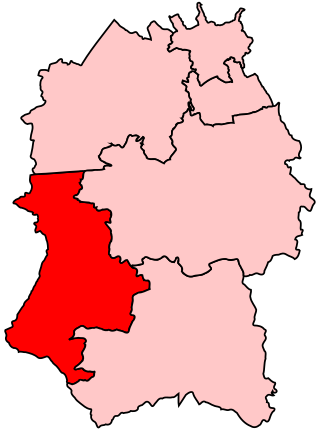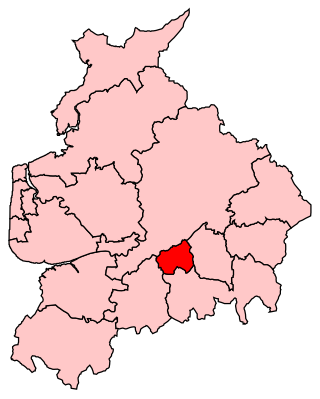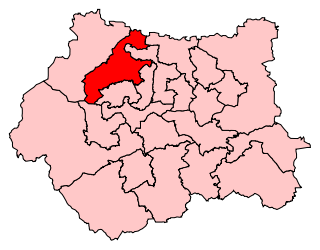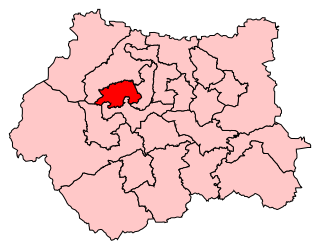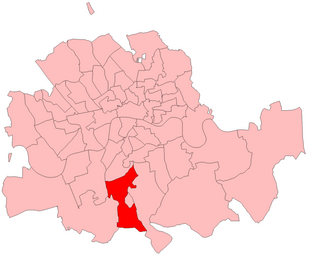Elections

| Election | Political result | Candidate | Party | Votes | % | ±% | ||
|---|---|---|---|---|---|---|---|---|
| 1951 general election [4] Electorate: 49,625 Turnout: 41,558 (83.7%) −0.9 | Labour hold Majority: 8,872 (21.4%) −5.7 Swing: 2.8% from Lab to Con | Maurice Webb | Labour | 25,215 | 60.7 | +2.0 | ||
| Arthur Tiley | Conservative | 16,343 | 39.3 | +7.6 | ||||
| 1950 general election [5] Electorate: 49,935 Turnout: 42,260 (84.6%) +8.4 | Labour hold Majority: 11,447 (27.1%) −3.8 Swing: 2.0% from Lab to Con | Maurice Webb | Labour | 24,822 | 58.7 | +1.2 | ||
| T. Boyce | Conservative | 13,375 | 31.7 | +5.1 | ||||
| Charles Frederick Sarsby | Liberal | 4,063 | 9.6 | −6.3 | ||||
| 1945 general election [3] Electorate: 38,331 Turnout: 29,205 (76.2%) +10.2 | Labour hold Majority: 8,988 (30.9%) +27.3 Swing: 14.2% from Con to Lab | Maurice Webb | Labour | 16,764 | 57.5 | +6.7 | ||
| T. L. Dallas | Conservative | 7,776 | 26.6 | −21.6 | ||||
| Peter Edward Trench | Liberal | 4,665 | 15.9 | N/A | ||||
| 1935 general election [3] Electorate: 47,906 Turnout: 31,638 (66.0%) −12.2 | Labour gain from Conservative Majority: 1,156 (3.6%) Swing: 13.2% from Con to Lab | William Leach | Labour | 16,397 | 51.8 | +13.2 | ||
| George Eady | Conservative | 15,241 | 48.2 | −13.2 | ||||
| 1931 general election [3] Electorate: 51,996 Turnout: 40,673 (78.2%) −1.8 | Conservative gain from Labour Majority: 9,289 (22.8%) Swing: 20.4% from Lab to Con | George Eady | Conservative | 24,986 | 61.4 | +20.4 | ||
| William Leach | Labour | 15,697 | 38.6 | −20.4 | ||||
| 1929 general election [3] Electorate: 52,674 Turnout: 42,141 (80.0%) +3.5 | Labour gain from Unionist Majority: 7,611 (18.9%) Swing: 10.7% from Unionist to Lab | William Leach | Labour | 24,876 | 59.0 | +10.7 | ||
| Anthony Gadie | Unionist | 17,265 | 41.0 | −10.7 | ||||
| 1924 general election [3] Electorate: 45,127 Turnout: 34,506 (76.5%) +5.5 | Unionist gain from Labour Majority: 1,202 (3.4%) Swing: 8.8% from Lab to Unionist | Anthony Gadie | Unionist | 17,854 | 51.7 | +21.3 | ||
| William Leach | Labour | 16,652 | 48.3 | +3.7 | ||||
| 1923 general election [3] Electorate: 44,991 Turnout: 31,939 (71.0%) −4.4 | Labour hold Majority: 4,516 (14.2%) +7.9 Swing: 3.7% from Unionist to Lab | William Leach | Labour | 14,241 | 44.6 | +1.8 | ||
| Jonas Pearson | Unionist | 9,725 | 30.4 | −5.7 | ||||
| Rev. William Paxton | Liberal | 7,973 | 25.0 | +3.5 | ||||
| 1922 general election [3] Electorate: 44,689 Turnout: 75.4% (+0.7) | Labour gain from Unionist Majority: 2,125 (6.3%) Swing: 13.0% from Unionist to Lab | William Leach | Labour | 14,296 | 42.4 | +11.1 | ||
| Fred Denby Moore | Unionist | 12,171 | 36.1 | −14.9 | ||||
| Rev. William Paxton | Liberal | 7,250 | 21.5 | +3.8 | ||||
| 1918 general election [3] Electorate: 44,549 Turnout: 24,374 (54.7%) −27.1 | Coalition Conservative gain from Liberal Majority: 4,798 (19.7%) Swing: 27.7% from Lib to Con | Henry Butler Ratcliffe | Coalition Conservative | 12,434 | 51.0 | +9.0 | ||
| William Leach | Labour | 7,636 | 31.3 | N/A | ||||
| Sir James Hill, Bt | Liberal | 4,304 | 17.7 | −40.3 | ||||
| 1916 by-election [2] Death of Sir George Scott Robertson | Liberal hold | Sir James Hill, Bt | Liberal | unopposed | ||||
| December 1910 general election [2] Electorate: 9,848 Turnout: 8,058 (81.8%) −8.1 | Liberal hold Majority: 1,296 (16.0%) −2.6 Swing: 1.3% from Lib to Con | Sir George Scott Robertson | Liberal | 4,677 | 58.0 | −1.3 | ||
| G. H. R. Pauling | Conservative | 3,381 | 42.0 | +1.3 | ||||
| January 1910 general election [2] Electorate: 9,848 Turnout: 8,857 (89.9%) +4.0 | Liberal hold Majority: 1,641 (18.6%) +3.0 Swing: 1.5% from LibU to Lib | Sir George Scott Robertson | Liberal | 5,249 | 59.3 | +1.5 | ||
| Viscount Howick | Liberal Unionist | 3,608 | 40.7 | −1.5 | ||||
| 1906 general election [2] Electorate: 9,978 Turnout: 8,568 (85.9%) +3.1 | Liberal gain from Liberal Unionist Majority: 1,340 (15.6%) +8.4 Swing: 4.2% from LibU to Lib | Sir George Scott Robertson | Liberal | 4,954 | 57.8 | +4.2 | ||
| Vicary Gibbs [6] | Conservative | 3,614 | 42.2 | −4.2 | ||||
| 1900 general election [2] Electorate: 10,442 Turnout: 8,641 (82.8%) +5.2 | Liberal Unionist hold Majority: 627 (7.2%) +6.6 Swing: 3.3% from Lib to LibU | James Wanklyn | Liberal Unionist | 4,634 | 53.6 | +3.3 | ||
| A. Anderton | Liberal | 4,007 | 46.4 | −3.3 | ||||
| 1895 general election [2] Electorate: 10,316 Turnout: 7,917 (77.6%) −0.7 | Liberal Unionist gain from Liberal Majority: 41 (0.6%) Swing: 2.9% from Lib to LibU | James Wanklyn | Liberal Unionist | 4,024 | 50.3 | +2.9 | ||
| George Shaw-Lefevre | Liberal | 3,983 | 49.7 | −2.9 | ||||
| By-election, 23 August 1892 [2] [7] Sitting MP seeks re-election | Liberal hold | George Shaw-Lefevre | Liberal | unopposed | ||||
| 1892 general election [2] Electorate: 11,434 Turnout: 8,955 (78.3%) +4.3 | Liberal hold Majority: 465 (5.2%) −0.2 Swing: 0.1% from Lib to LibU | George Shaw-Lefevre | Liberal | 4,710 | 52.6 | −0.1 | ||
| Marquess of Lorne | Liberal Unionist | 4,245 | 47.4 | +0.1 | ||||
| 1886 general election [2] Electorate: 11,297 Turnout: 8,361 (74.0%) +2.9 | Liberal hold Majority: 459 (5.4%) −4.4 Swing: 2.2% from Lib to LibU | George Shaw-Lefevre | Liberal | 4,410 | 52.7 | −2.2 | ||
| Charles Norwood | Liberal Unionist | 3,951 | 47.3 | +2.2 | ||||
| By-election 21 April 1886 [2] Death of William Edward Forster Electorate: 11,297 Turnout: 8,032 (71.1%) −8.6 | Liberal hold Majority: 780 (9.8%) −4.4 Swing: 3.7% from Lib to Con | George Shaw-Lefevre | Liberal | 4,407 | 54.9 | −3.7 | ||
| Edward Hoare | Conservative | 3,627 | 45.1 | +3.7 | ||||
| 1885 general election [2] New constituency Electorate: 11,297 Turnout: 9,007 (79.7%) | Liberal win Majority: 1,543 (17.2%) | William Edward Forster | Liberal | 5,275 | 58.6 | |||
| George Motley Waud | Conservative | 3,732 | 41.4 | |||||
